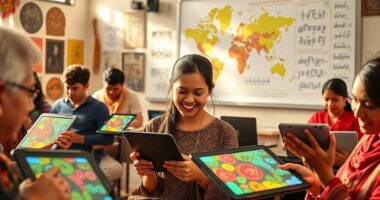As we navigate through the ever-evolving landscape of technology, it is evident the profound impact it has had on language and culture.
From the way we communicate to the preservation of linguistic diversity, technology has undoubtedly reshaped the way we interact with one another and express our cultural identities.
But what exactly are the implications of this influence? How has technology altered the fabric of language and culture, and what does this mean for our global society?
Key Takeaways
- Technology plays a significant role in the global exchange and preservation of languages, making languages more accessible and efficient to learn.
- Digital communication and AI technologies have the potential to bridge the language gap, facilitate language exchange, and preserve endangered languages and cultures.
- Technology contributes to shaping language identity by providing increased access to authentic language materials, personalized language learning experiences, and facilitating cross-cultural communication.
- In the digital age, technology helps break down language barriers, fostering inclusivity and unity, but challenges such as the digital divide and language inequalities must be navigated with sensitivity and awareness.
The Influence of Technology on Linguistic Evolution
The digital age has significantly impacted the evolution of languages, fostering global exchange and preservation while also presenting challenges for linguistic communities.
In today's globalized world, language learning is being revolutionized by using technology. With new technological advancements, language acquisition has become more accessible and efficient, breaking down barriers and connecting people from diverse linguistic backgrounds. Translation tools and language learning apps are empowering individuals to learn new languages and preserving endangered languages that are at risk of being lost. This not only facilitates cross-cultural communication but also contributes to the revitalization of linguistic diversity.
However, it's essential to acknowledge the digital divide, which can exacerbate language inequalities and marginalize certain linguistic communities. Despite these challenges, AI technologies are playing a crucial role in bridging the gap between written language and speech psychology, enhancing cross-cultural communication and understanding.
Moreover, digital technology, such as the Woolaroo app and Duolingo, is instrumental in the preservation and revitalization of endangered languages and cultures. These advancements reflect the positive impact of technology on linguistic evolution, creating opportunities for inclusive language learning and the preservation of diverse linguistic heritages.
Digital Communication and Cultural Expression

As technology continues to reshape our digital landscape, cultural expression and communication have become increasingly intertwined, reflecting the diverse tapestry of global societies.
The advent of new digital technologies has facilitated the exchange and preservation of languages across borders, playing a pivotal role in shaping cultural diversity. Moreover, AI technologies are instrumental in bridging the language gap and understanding cross-cultural communication nuances, fostering a deeper global societal understanding.
One notable impact of digital technology is the preservation and revitalization of endangered languages, exemplified by innovations like the Woolaroo app and traditional language nesting techniques. These advancements offer opportunities to expand cultural understanding and celebrate the unique aspects of human societies worldwide.
In this digital age, language and speech aren't solely means of communication but are also integral components of cultural expression, enabling individuals to share their heritage and traditions with a global audience.
As we harness the power of technology, we can continue to strengthen the cultural fabric of our global society, fostering greater understanding and appreciation for diverse cultural expressions.
Technology's Role in Shaping Language Identity
Amidst the ongoing evolution of digital communication and cultural expression, technology's influence on shaping language identity becomes increasingly apparent. As technology continues to shape our linguistic landscape, it is crucial to understand its impact on language, culture, and identity. Through technology, we are witnessing a transformation in the way languages are learned, preserved, and communicated globally.
| Advantages of Technology in Shaping Language Identity | Challenges of Technology in Shaping Language Identity |
|---|---|
| Increased access to authentic language materials | Not a substitute for in-person language instruction |
| Interactive and personalized language learning experiences | Potential anxiety or frustration for some language learners |
| Facilitation of cross-cultural communication | Limitations in preserving endangered languages |
| Contribution to the preservation of endangered languages | Influence on language reforms and cultural diversity |
Technology has become a powerful tool in promoting multilingualism, facilitating the learning of a second language, and preserving endangered languages. However, it is essential to recognize the limitations and challenges that come with integrating technology into language learning and preservation efforts. Overall, technology plays a significant role in shaping language identity, influencing cultural diversity, and bridging linguistic barriers in our interconnected world.
Cross-Cultural Communication in the Digital Age

In navigating the digital age, we adapt to diverse communication styles and norms across different cultures in order to facilitate cross-cultural communication effectively. The use of technology plays a pivotal role in breaking down language barriers, enabling us to speak the language of others through translation tools, AI, and digital platforms.
This not only fosters understanding but also promotes inclusivity and unity, especially in the face of significant political events. However, it's crucial to acknowledge the challenges that come with this digital interconnectedness. The digital age brings to light the digital divide, language inequalities, and the potential loss of cultural diversity, emphasizing the need for mindful and responsible use of technology in cross-cultural communication.
Furthermore, this intersection of technology, language, and culture in the digital age shapes global dynamics, influencing how languages are disseminated, preserved, and revitalized, while also impacting cultural identity and diversity. As we embrace the opportunities that technology presents for cross-cultural communication, it's essential to navigate this space with sensitivity and awareness of the cultural nuances that define our shared global community.
Preservation of Language and Culture Through Technology
Utilizing technology has significantly enhanced the preservation of language and culture through various innovative tools and platforms.
Digital technology has revolutionized language learning by providing increased access to authentic materials, such as manuscripts, music, film, and maps, which deepen understanding of different cultures.
Tools like StoryMap, Tiki-Toki, Quizlet, and Glogster are utilized in language classes to enrich the learning environment and engage different types of learners, contributing to the preservation of language and culture.
Additionally, language translation tools and AI play a crucial role in bridging language barriers and facilitating cross-cultural communication. Apps like Duolingo and initiatives like the Woolaroo app also contribute to the preservation and revitalization of endangered languages and cultures.
However, it's important to recognize that while technology has transformed language acquisition and preservation, it presents challenges such as the digital divide and can't replace in-person language instruction.
As we continue to embrace technology in language education, it's essential to find a balance that preserves the richness of traditional teaching methods while leveraging the benefits that technology offers for the preservation of language and culture.
Frequently Asked Questions
What Is an Example of a Technology Language?
We think an example of a technology language is Google Translate. It uses language translation and technological innovation to facilitate cross-cultural communication.
It's a fantastic tool for language evolution and digital communication. The programming language and technological integration behind it make it a valuable resource for linguistic programming.
It's a great example of how communication technology can serve others by breaking down language barriers and promoting global understanding.
What Are Some Examples of Technology Culture?
Examples of technology culture include:
- The widespread adoption of social media
- The impact of innovation trends on daily life
- The influence of technology on societal norms
Technology adoption has reshaped how we connect and communicate, fostering cultural exchange and collaboration.
With the rise of social media influence, cultural expressions and practices have become more globalized.
Innovation trends continue to shape our cultural landscape, driving change and adaptation in various aspects of our lives.
How Is Language Related to Technology?
Language evolution is closely connected to technology, shaping digital communication and coding language. It has also influenced the development of linguistic interfaces, enabling seamless interaction with devices.
As a result, technology has significantly impacted how languages adapt and change over time, reflecting the evolving needs of communication.
This intersection of language and technology continues to redefine the way we interact, learn, and communicate in our increasingly interconnected world.
What Is Meant by Technological Culture?
We see technological culture as the influence of innovation adoption on societal values and cultural impact.
It's like a river shaping the landscape – technology shapes societal behavior and is shaped by cultural values.
Our understanding involves recognizing this reciprocal relationship and how it impacts language preservation, cultural identity, and the exchange of cultural practices on a global scale.
Conclusion
In conclusion, technology has significantly impacted language and culture.
75% of language learners use digital tools to enhance their learning experience.
From linguistic evolution to cross-cultural communication, technology has revolutionized the way we interact and express ourselves.
As we continue to embrace the advancements in technology, it's important to recognize the opportunities it presents for preserving language and culture.
At the same time, we must acknowledge the challenges it brings in maintaining linguistic diversity.
Talise is a talented writer and an expert in her field. Her unique perspective and insights enrich our content with depth and authenticity. With a wealth of knowledge and a strong connection to the subjects she writes about, Talise crafts engaging and informative articles that resonate with our readers. Her dedication to bringing Indigenous culture and wisdom to light is truly commendable.










